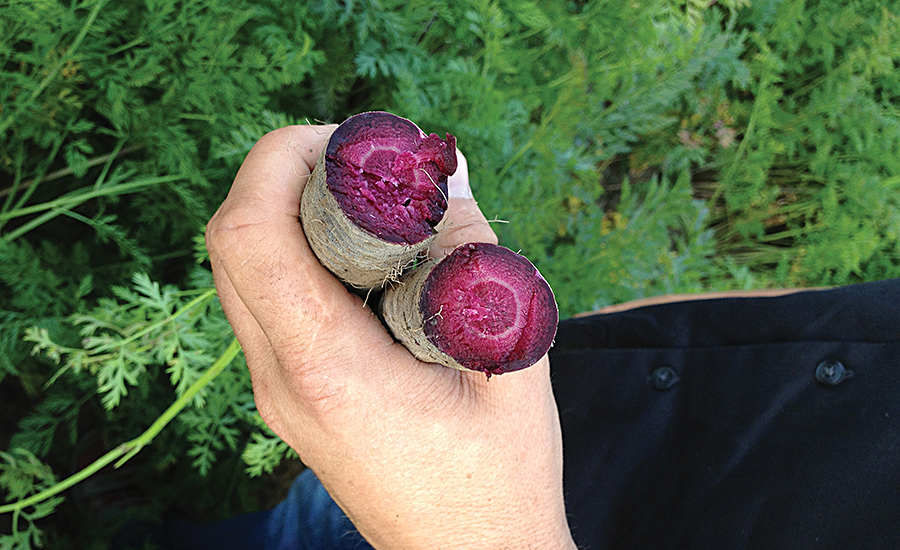Natural Food Colors in Product Development
Where food colorants are concerned, there are unstoppable changes afoot in the industry

Naturally red and purple carrots have extended the root’s use as a colorant source beyond the traditional orange and yellow tones.
SOURCE: Naturex USA (www.naturex.com)

Ingredient technologists are becoming expert at recreating naturally vibrant primary and secondary colors formerly available only artificially.
SOURCE: Sensient Colors LLC (www.sensientfoodcolors.com)

Increasing the color content of raw materials such as fruits and vegetables can require the development of special cultivars.
SOURCE: FMC Corp. (www.fmcbiopolymer.com)

Red-toned caramel colors now are available to provide a range of tones from rust to red velvet in food and beverage applications.
SOURCE: Sethness Products Co. (www.sethness.com)

New sources of non-artificial colors can now be used in formulations requiring extremes of temperature, such as high-heat baking.
SOURCE: IFC Solutions Inc. (www.ifc-solutions.com)

SOURCE: IFC Solutions Inc. (www.ifc-solutions.com)






The “natural colors only” movement resulted in sweeping reductions in the use of synthetic colorants and, understandably, a concurrent rise in interest in naturally derived food colorants. It also has driven a move to a new regulatory distinction currently undergoing formalization in the EU: “coloring foods.” These are food colorants derived from natural sources but processed in ways that retain the more natural identity of the colorant. Colorants that meet this definition are being presented as a marketing advantage in developed markets around the world.
Today’s food manufacturer is faced with, what is for some, a substantial dichotomy. There is a great deal of information to evaluate regarding consumer preferences, on the one hand, and technical feasibility and economics on the other. The challenge becomes making a sound decision about what colorants to choose to meet current demands for clean labels, while maintaining as much as possible the quality, safety, appearance, shelflife, and profitability of existing product formulations.
Decades of experience with synthetic food colorants trained food manufacturers to expect ease of use, broad application, good stability, consistent performance, and low cost from their food colorants. Nature, on the other hand, developed coloring substances for specific applications and that are designed to degrade in relatively short order. The challenges vary, however, depending on what natural colorant is chosen.
I Am Curious Yellow
Naturally derived food colorants come from many sources, and the coloring principals—the molecules that provide the coloring effect—belong (mostly) to relatively well-understood classes of substances. Most carotenoids (annatto, beta-carotene, oleoresin paprika, carrot extract, lycopene, lutein, apocarotenal, astaxanthin, canthaxanthin, and others) are, as a rule, oil-soluble substances with limited water solubility. The notable exceptions are saffron, gardenia extract (permitted in Asia), annatto extract (in the form of norbixin), and safflower extract (permitted in the EU).
The strongly oil-soluble members of this family can be rendered water-dispersible with the use of compatible food-grade surface active agents (surfactants). In the past, surfactants, such as polysorbate-80 and monoglyceride preparations, have been successfully used, but these can run afoul of current expectations for clean ingredient statements.
From a regulatory perspective, this is not an issue as, according to current regulations in the US, it is not necessary for diluents (dilutant) and processing aids in these preparations to be declared on the final food product label.
The color shades of these carotenoids vary from the characteristic orange of annatto and the orange-red of paprika, to the yellow and yellow-orange of lutein and saffron. Given the differences in solubility, care must be taken to select the correct formulation of these colorants to suit a given application.
Turmeric, and its coloring principle curcumin, have become highly popular, as more and more health-related information is disclosed about the vivid yellow-gold antioxidant. Among its many interesting properties is its color impact. Curcumin is an excellent color match for FD&C Yellow #5. Performance is quite another issue, however, due to its light sensitivity.
Food products colored with turmeric oleoresin fade quickly in direct light. (It would be useful to have a food-grade “sunscreen” that would protect the color, but so far none is known to exist.) This has limited the use of turmeric as a food colorant to those applications where the finished product is not exposed to direct light.
Contrast this with safflower extract. This product has long been permitted for use in the EU, but it is not currently permitted in the US. But it produces a vivid lemon-yellow color that is quite stable to both heat and light. It would fill a substantial performance gap as a natural replacement for FD&C Yellow #5, if it was permitted in the US.
Rainbow of Opportunity
In the search for FD&C Red #40 replacements, many developers have turned to extracts of red vegetables, especially red beet juice. It provides a vivid red color with blue tones and historically has been used to mimic berry shades in applications such as yogurt. It performs less well in high water activity formulations where there is substantial exposure to heat. The beet extract colorant, betanin, degrades more rapidly in high water activity environments with exposure to heat. Exposure to heat also drives a browning reaction between other components of the ingredient.
Ultimately, these two factors can cause color fade or cause browning in the food product. As scientists have developed a better understanding of the degradation mechanism(s), it has been possible to identify some ways to mitigate these negative effects. These generally involve minimizing exposure to unfavorable conditions by controlling where and when the colorant is added to the process.
The need to extend the palette of natural green, natural blue, and natural black colors has food manufacturers seeking replacements for synthetic colorants. This is because they quickly find natural blues and greens are difficult to achieve in many food applications. The most commonly recommended natural green is chlorophyll. It can be found readily in spinach, other green leafy vegetables, and some herbs.
Natural greens also have been obtained through extraction from alfalfa. Some of the commercially available products have flavor and aroma issues that could present a challenge, depending on the application. There are some issues with solubility and pH stability, as well. In the US, the challenge is that the range of permissible uses is limited by current regulations.
Spirulina has been approved for limited use as a natural blue food color. Its use at present is uncommon, due to performance and stability issues, limited availability, and cost in use. It is reported to work well in cake decoration and frosting, where the pH is near neutral, and water activity is limited. Acidity and high water activity, along with the application of heat, cause rapid fading. It can find use in certain types of dry mix formulations, such as gelatin desserts. At present, spirulina extracts are not finding significant application in beverages or where there is high heat during processing.
In the US, there is no natural black colorant currently allowed. In the EU, carbon black (vegetable carbon) is permitted for limited use, but there is no present prospect for approval by the FDA. Squid ink is mentioned from time to time in conversation, and it currently is used in highly limited quantity in traditional black squid ink pasta. But squid ink is an allergen and also cannot be used in kosher- or vegetarian/vegan-certified items. It is not approved for use as a food colorant in the US or the EU.
Carmine continues to be heavily criticized in the press, because of its origin. It is extracted from the dried bodies and eggs of an aphid-like insect that lives on a certain species of cactus. Peru and the Canary Islands are the primary sources, although the raw material can be found in Chile and Mexico. Because of its insectoid origin, the product is not kosher, nor is it suitable for use in vegan or vegetarian products.
It has also been discovered that a small percentage of the population might have an allergic reaction to carmine because of the natural protein content that is necessary to its functionality as a color. As the supply constricts and prices rise, it becomes more economical to harvest the raw material again. These fluctuations in raw material supply historically have led to dramatic fluctuations in the cost of carmine and carminic acid.
There have been ongoing efforts to find a natural red color that can function as well as carmine, while avoiding the issues mentioned above. Various tomato-derived reds and other natural sources are coming forward, with functionality coming close to carmine and artificial reds. Colorant technology is helping these substitutes perform at least well enough that marketing teams can take over and make products that use such natural reds desirable to a concerned consumer base.
Color Me Dairy
Annatto color has been a mainstay of the global natural cheese production industry for decades. The uniquely favorable characteristic of annatto extract is its ability to selectively bind to milk proteins. This ensures that most of the color winds up in the cheese curd. The unfortunate drawback is that a small proportion stays with the whey.
For whey producers, however, this presents a problem, as the commercially desirable whey protein powders are ideally white—not orange. Whey processors traditionally have been required to treat the supply stream to eliminate the residual annatto presence in whey powder.
It always has been possible to achieve the color effect of annatto in Cheddar and Colby cheeses with other coloring materials, such as combinations of oleoresin paprika with other carotenoids. However, these combinations do not readily bind effectively to the milk proteins, so much of the color is lost to the whey.
Recent technological advances have led to formulations that color the curd effectively and leave no residual color in the whey. This eases the demands on the whey processors. The result is that access to this cleaner whey is expected to reduce the value of whey from annatto-colored cheeses.
Caramel Dreams
Caramel food colorants have been a mainstay in the food and beverage industry for decades. It is difficult to imagine a cola without the now-characteristic caramel coloring. (In fact, it was tried once and was a complete debacle. Pepsi Clear, anyone?) Caramel colorants are used throughout the food industry, especially in beverages and baked goods, to provide light yellow-brown (tan) colors to very dark, almost black colors.
Caramels are produced by the controlled heating of liquid reducing sugars. The caramelization reaction is a browning reaction similar to that observed when bread is baked or toasted, coffee is roasted, meat is cooked, and potatoes are fried. Industrial production of food-grade caramel colorants is catalyzed by the use of certain types of food-grade chemical additives (acid, alkali, sulfur dioxide) that drive the caramelization reaction to completion and influence the characteristics of the final product.
The type of catalyst used determines the class of caramel (I, II, III, or IV). The class of caramel determines in which application it is best used. For example, class IV caramels are used most commonly in beverage applications like colas.
A substance called 4-methyl imidazole (4-MeI) is produced in a side reaction of the caramelization process in some situations. Several years ago, the presence of this substance raised concerns about the safety of caramel food colorants. A fact sheet published by the California Office of Environmental Health states: “Products that potentially contain 4-MeI include certain colas, beers, soy sauces, breads, coffee, and other products,” and “cooking, roasting, or other food processing, such as the roasting of coffee beans, could also lead to formation of 4-MeI.”
Toxicology studies in animals have found some effects at extremely high doses (comparable to a human consuming hundreds of cans of cola per day), and both the FDA and EFSA have taken the position that caramel food colorants are safe at current levels of consumption. In 2011, California chose to place 4-MeI on its list of probable carcinogens and established a “no significant risk level” of 29µg per day.
The total replacement of caramel food colorants would require attention to several issues. Caramel colors are inexpensive to use in comparison with other potential replacements. They also are uniquely well-suited to applications, such as beverages and baked goods, where they are simple to use, highly functional, and stable.
Most importantly, caramel colors typically are natural, clean label ingredients that resonate well with consumers. Unlike many colorants, they have an added psychological aspect of “comfort indulgence,” in addition to their versatility, low cost, and ease of use. Even with the 4-MeI scare, few consumers balked at enjoying foods with caramel colors. This was especially true once it was perceived that it was, at best, a tempest in a teapot.
The Money of Color
Potential replacements of artificial colorants generally carry a much higher cost-in-use and cannot provide the level of functionality across a wide range of applications. Carmine, for example, is the aluminum lake of carminic acid. Carmine and carminic acid historically are significant food, cosmetic, and fabric colorants that are as stable as almost any synthetic colorant in most food systems. They are highly resistant to heat and light. They also are quite stable toward oxidative conditions. However, carmine is expensive in comparison to synthetic colorants, costing as much as 10-20+ times as much on a cost-in-use basis.
Most synthetic dyes can be obtained at levels of 88-90% purity or higher. Synthetic lakes are produced in three color strengths: low (10-12%), medium (20-24%), and high (30-34%) dye content. Carminic acid can be obtained in 95% purity, and carmine contains a relatively high coloring component content (~52% by regulatory definition).
Preparations of carminic acid or carmine in liquid form generally are much lower in colorant content, which then requires a higher dosage to achieve the desired coloring effect. The higher per-unit cost, plus the potentially significantly lower color content conspire to drive up the relative cost of using these natural colorants.
Since natural colorants typically are less economical on a cost-in-use basis, it is desirable to find ways to minimize the cost impact. One factor that leads to the higher cost is the relatively low concentration of color in the raw material and, frequently, in the finished color preparation. There are two ways to address the issue.
The first and most obvious is to increase the color content of the raw material. This is a challenge, because it requires the development of special cultivars or alternative methods for the production of the color. Selective breeding can lead to special cultivars that produce higher yields of a selected colorant.
These gains generally are small, because the starting concentration of the colorant is often very small (a few percent at best). The economic impact can be favorable, but it is not a game-changer in terms of reducing cost-in-use.
The second method is to find alternative ways to produce the color. Beta-carotene occurs naturally in many plants. The orange carrot is most commonly thought of in this context. However, the majority of the beta-carotene produced and consumed in the US is a nature-identical product made by a synthetic chemical process which was developed decades ago.
Natural beta-carotene can be readily sourced from salt-tolerant algae or extracted from red palm oil. However, palm oil carotene does not meet the standard of identity for beta-carotene in the US, because it is a mixture of beta-carotene with other related carotenes. The standard of identity requires that the carotenoid content be 95% beta-carotene.
Efforts at selective breeding to obtain higher color yields seem to be limited. Alternative production methods could hold more promise, but they also carry risks. For example, it’s possible to use genetic modification to achieve a higher producing cultivar or a modified microbe that over-produces color. However, it then ceases to be “natural” by many definitions. (NB: There still is no legal definition of the term “natural.”)
Selective extraction methods can be extremely efficient at isolating and concentrating coloring substances. Then the question must be asked, does the production method lead to a finished good that is no longer natural by the definition prevalent at the time? Solvent extractions and genetic modification are both triggers for discussion of the natural origin of any food product these days.
Titanium dioxide (TiO2) is the world’s best food-grade whitening and opacifying agent. It is made though a chemical process involving titanium-containing ore that is processed and purified to achieve the bright white and chemically highly inert powder. It has been used for decades as a white colorant in many applications, including some foods.
Because of the chemical name, TiO2 is on a hit list of colorants for which replacements are being sought. The food industry has been searching for years for a suitable replacement, and, in a limited number of applications, alternatives have been found. Still, the unique performance of TiO2 has proven highly difficult to duplicate with other, more consumer-friendly ingredients.
As a solution, some companies have developed natural white colorants that can fill the bill. Microencapsulated calcium carbonate has been used in this manner to good effect. It is resistant to low pH, oxidation, and light.
Regulatory Framework
Colorants permitted for use in food are regulated by the FDA. Food colorants must appear on a positive list of permitted substances. (The governing regulations are found in 21 CFR, Parts 73 and 74 at http://1.usa.gov/1pLgdtw.) Similarly, permitted food colorants in the EU are governed by food-safety regulations and must appear on a positive list (http://bit.ly/1N3RGer).
EU regulations include numerical designations for ingredients and additives for use on food labels. These numbers are preceded by the letter “E” and thus referred to as E-numbers. As an example, red beet root juice is E162. Because of their association with additives and unfamiliar food components, such as preservatives, synthetic food colorants, and additives, E-numbers are negatively perceived by consumers in the EU.
In the US, consumers are more familiar with the standard designations provided in the CFR. For the most part, these designations do not raise the level of concern that E-numbers have in the EU.
At least partly due to a backlash by consumers concerned about chemicals in food, there is a relatively new trend in the EU of “coloring foods” or “foods that color.” The concept is that certain foods have coloring capabilities, as well as value as a food. If these products are minimally processed or processed only by the most natural of methods, they can be thought to retain their identity as foods. As such, they should be labeled as a food rather than as a colorant with an E-number.
The regulatory definition is now being finalized via the European Commission with input from NATCOL, EFSA, and other interested parties. The result has been the issuance of guidance notes on the classification of foods with coloring properties.
A key point is the establishment of an enrichment factor. The content of the coloring component in the food is compared to a nutritive component, such as carbohydrate, protein, or fat, and that occurs with the colorant in the source. To conform with the EU guidance, the relative content of the coloring factor and the nutritive constituent should remain roughly the same. An enrichment factor of “6” has been determined to be the control point, and selective concentration of the coloring component is not permitted to occur beyond the enrichment factor limit.
Food colorant preparations based on spinach and nettle (green, chlorophyll), carrot and paprika (orange), carrot, turmeric and safflower (lemon yellow) all have a long history of successful use in the EU. It has been accepted that they represent foods that provide color, but they no longer meet the definition of a coloring food, as it is currently set forth. While adjustments in processing methods to achieve a “coloring food” designation could result in a marketing advantage, there may also be complications that arise that might reduce the color impact or functionality.
Previous mention had been made of safflower extract and its long history of successful use as a natural colorant in the EU. It is prepared using a solvent extraction process, which produces a concentrated coloring preparation. It provides a bright lemon-yellow color. To comply with the “coloring food” designation, it would have to be extracted using a modified process where the organic solvent is replaced with water.
This process produces a less-vivid colorant, so some of the aesthetic value of the color would be sacrificed to achieve the “coloring food” designation. If coloring preparations of red beet juice that meet the coloring food definition also contain higher amounts of other plant materials, such as fibers or other carbohydrate fractions, it should be expected that browning could be a greater problem.
Consumer demand for cleaner labels and natural ingredients favor the replacement of synthetic food colorants with colorants derived from natural sources. The inherent differences between synthetic and natural food colorants present challenges for the food manufacturer, where performance and cost are concerned. These challenges also represent substantial opportunity as consumer preferences evolve.
Originally appeared in the June, 2016 issue of Prepared Foods as Color It Natural.
Along the Supply Chain
The pace of adoption of some natural colorants can result in unforeseen supply-chain hurdles.
As an example, FD&C Red 40 is one of the most used synthetic food dyes. Red beet juice is one natural colorant that is an approximate shade match. Red beet juice has certain performance issues, but demand is still increasing, as replacements are sought for Red 40. The problem then becomes one of supply.
Obtaining red beet juice concentrate requires planting and growing necessary acreage of beets; successful harvests; and specific processing capabilities. And, with only one crop per year, it is necessary to plan well in advance to have the right amount of product to meet demand. Rapid fluctuations in demand create substantial headaches for the growers and processors attempting to fill the need.
Economic forces could restrict the supply of colorant raw materials in some cases. For example, the raw material for carmine production must be harvested by hand and dried before it can be transported and processed. Given the relatively remote areas where most production occurs, consolidation and transportation to processing facilities can complicate the process. If the supply becomes too large and prices become too low, then workers move to harvest other crops, and the supply of the raw material becomes constricted.
Synthetic Myths
Since the 1970s, there has been a growing perception that permitted, certified (read: “synthetic”) colorants cause health problems. The most recent driver of this thinking is the 2011 “Southampton Study.” Produced by a team in the UK, the study purports to show a connection between certain health concerns and the consumption of foods and beverages containing a combination of ingredients, including some synthetic food colorants.
The study has been criticized by experts in the field, but it has become part of a body of thought finding resonance among those increasingly suspicious of the quality and safety of processed foods. This suspicion remains, in spite of the fact that the current set of permitted synthetic food colorants is among the most tested of any food additives. Extensive testing of the toxicology and safety of these ingredients supports the current FDA position that usage within the recommended guidelines is safe.
Looking for a reprint of this article?
From high-res PDFs to custom plaques, order your copy today!












